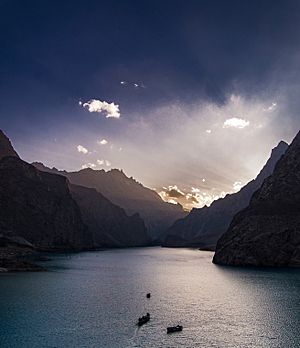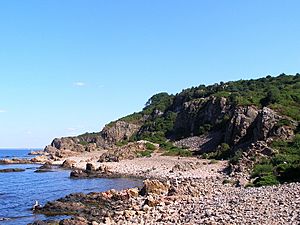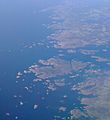Kattegat facts for kids
The Kattegat is a sea area about 30,000 square kilometers in size. It's located between the Jutland peninsula in Denmark and the countries of Sweden and Denmark. The Baltic Sea flows into the Kattegat through the Danish Straits.
The Kattegat is quite shallow. It used to be very hard and dangerous for ships to travel through. This was because of many sandy and stony reefs and tricky currents. Today, special channels have been dug in the seabed. Many reefs have been cleared, and a good network of lighthouses helps guide ships safely. This is important because many ships use this small sea.
Several big cities and important ports are located on the Kattegat. These include Gothenburg, Aarhus, Aalborg, Halmstad, and Frederikshavn.
Contents
History of the Kattegat
Controlling the Kattegat has always been very important for sea travel. Before the Eider Canal was finished in 1784, the Kattegat was the only way to sail into and out of the Baltic Sea region.
Starting in 1429, during the Middle Ages, the Danish royal family made a lot of money from something called the Sound dues. This was a special fee charged to ships passing through the Øresund, a strait in the Kattegat. The city of Copenhagen also offered a safe place for ships to stop, trade, get repairs, and be protected from piracy. These fees were finally stopped in 1857.
Protecting the Kattegat's Environment
In the 1970s, scientists noticed that the Kattegat was one of the first marine "dead zones". A dead zone is an area in the sea where there isn't enough oxygen for most marine life to survive. This problem was caused by a lot of industrial activities nearby.
Since 1985, Denmark and the European Union have started expensive and big projects. These projects aim to stop, fix, and prevent environmental damage in the Kattegat. They want to protect the sea and its living creatures.
Special Protected Areas
Because there is a lot of ship traffic and many towns along its coasts, the Kattegat has special rules. Since 2006, it has been a Sulphur Emission Control Area. This means ships must use cleaner fuel to reduce pollution.
Many parts of the Kattegat are also protected as Natura 2000 sites. Some areas are protected for birds under agreements like the Ramsar Convention. The shallow reefs in the Kattegat are especially important. They are places where fish and marine mammals lay their eggs and find food. These reefs help support a rich variety of life, known as biodiversity, which needs protection.
Images for kids
-
There are several offshore windfarms in Kattegat.
-
All the Danish coasts in Kattegat are sandy or gravel beaches with no exposed bedrock.
See also
 In Spanish: Kattegat para niños
In Spanish: Kattegat para niños











